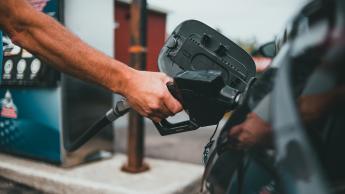Ask an Expert: Why is Gas So Expensive Right Now?

With gas prices at a record high going into the summer — about $5.60 on average in California — we asked Professor Hamed Ghoddusi, who studies the economics of energy and commodity markets, what factors are causing the spike — and what consumers can do about it.

What has been driving the intense recent increase in gas prices?
A lot of people correctly think immediately about the base component, the crude oil price, which has jumped to $110 per barrel. We’ve had similar oil prices all the way back to 2008. However, if you look at gas prices, and in particular in California, it’s completely unprecedented.
Part of that increase, which might be hidden to consumers, is what’s known as “crack spread,” the markup for refining gas. Historically, that markup is usually around $7-10 per barrel. I'm currently calculating that markup at $28 per barrel. That’s because natural gas is used in oil refining, and the price of natural gas has also gone up. Altogether, the cost of refining has almost doubled compared to last year.
This is all coinciding with the Russian invasion of Ukraine. Is that a factor?
It’s a causal factor, absolutely. However, even if there was no Russian invasion, we still would have experienced some price increases, because during COVID the U.S. oil industry lost some capacity, and also due to inflation. But now on top of those, because of the Russian crisis, some countries put an embargo on both natural gas and crude oil from Russia. That means we’re cutting off some of the supply from there, which is adding friction to energy markets. Russia is a major producer — about 10% of the global oil market, and the crude oil market is very sensitive to supply issues. If you cut even a little bit from the supply, prices will go up significantly.
How long might this situation last, and what are some of the factors that could eventually bring the price back down?
Regular price fluctuations are usually short-lived, because the root cause is usually a temporary thing — a burst in a pipeline somewhere, a problem at a refinery, a blizzard. The difference now is that we have what’s called a “structural shock,” a real supply deficit due to the ongoing war and the COVID-related issues. And even if the war stops right now, rebuilding the global supply will take time. It’s not a phenomenon that is going to go away overnight. If OPEC (the Organization of Petroleum Exporting Countries) is willing to cooperate to increase their oil supply to the global market, that might be a small factor to help. I think the European shift from Russian oil and gas is going to continue, and it will take at least a few quarters until we can go back to a normal situation. I don’t see a fast-forward way of bringing it back down to $50 or $60 per barrel overnight.
What are some things that governments can do right now to help relieve the pressure on consumers?
In some countries, a big proportion of the pump price comes from the taxes that the government levies. In the U.S. that comes out to about 15 cents per gallon, and in California, those taxes are much higher, about 60 cents more per gallon. California also has much higher environmental standards that further increase the price. Now there’s pressure for governments to reduce those taxes and loosen those standards temporarily. The U.S. government also has hundreds of millions of barrels in the national strategic reserves, and they have decided to bring some of that back to the market. We can work with other oil-producing countries and encourage them to try to increase the supply. All of these maneuvers may help the supply get to consumers more efficiently, but at the end, the problem is the real supply shortage.
Is there anything consumers themselves can do in the meantime?
Of course, anything that reduces consumption is helpful. Less driving, more public transportation, cycling, carpooling or using smaller, more efficient vehicles wherever possible. During COVID we also found that some people can work from home. The International Energy Agency suggests that working from home can reduce somewhere in the order of half a million barrels of gasoline consumption. But those solutions may not be at the disposal of everybody. In the meantime, trying to eliminate unnecessary trips can shave a little bit of demand at the consumer level.
Want more Learn by Doing stories in your life? Sign up for our monthly newsletter, the Cal Poly News Recap!



